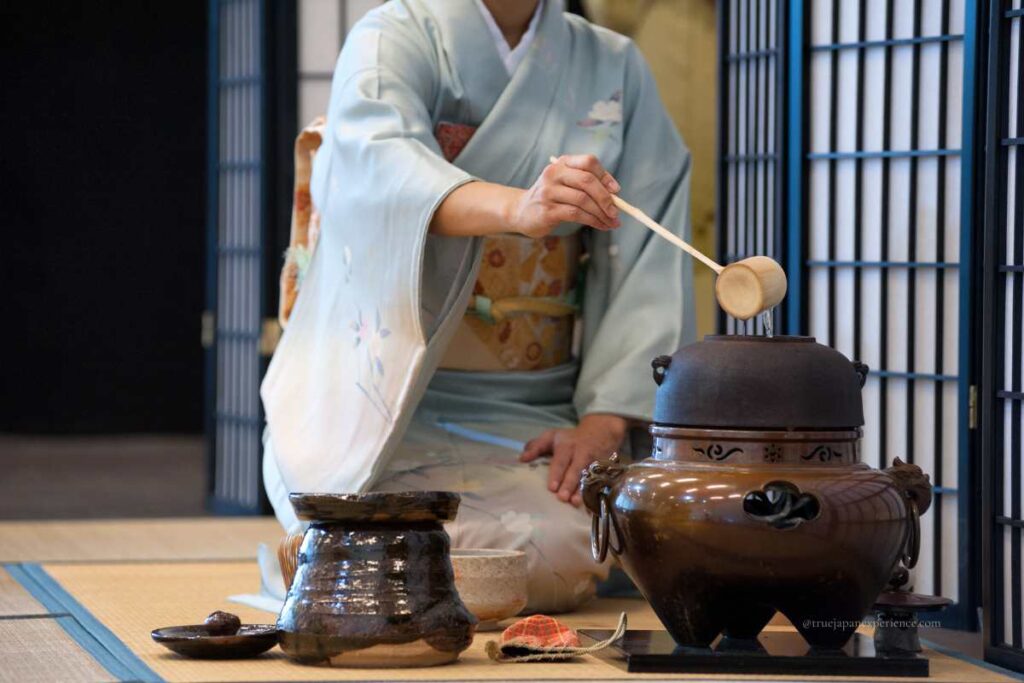Omotenashi in Japan is often translated as “hospitality,” but its meaning goes far beyond that simple word. It is not only about welcoming guests or offering good service. Instead, it reflects a deeper cultural mindset—one that values sincerity, respect, and thoughtful care for others.
For many people in Japan, omotenashi is not a performance or duty. It is something natural, something done quietly, without expecting praise or reward.
In this article, we explore what omotenashi truly represents in Japanese culture, and how it continues to shape daily life in both traditional and modern settings.
The Heart of Omotenashi in Japan

The word omotenashi is often explained by looking at its parts.
One origin comes from the verb motenasu, which means “to treat someone with care.”
Another way to understand it is through the words omote (meaning front or surface) and nashi (meaning none), suggesting that there is no hidden side. In other words, omotenashi means showing kindness and respect with an open and honest heart.
This way of thinking is one of the most important values in Japanese culture.
When people practice omotenashi, they don’t follow a script. It’s not about rules or money. Instead, it begins with a simple wish—to make someone feel welcome and cared for.
Omotenashi was not created for business or service industries.
Its roots go deeper. It began in traditional customs like the tea ceremony, and also in everyday life. The core idea is to treat the person in front of you with respect, attention, and care.
This spirit grew naturally within Japanese culture—not from contracts or payments, but from human relationships.
Omotenashi is not limited to hotels or restaurants. It exists in the home, in the community, and even between strangers.
Whether with close friends or someone you meet for the first time, the same quiet care can be shown. That is why omotenashi is not just about service—it is part of the Japanese way of life, passed down through generations.
People who offer omotenashi don’t try to stand out. Their actions may go unnoticed, and that’s okay. The kindness is still real, even if no one says anything. For them, just being able to help or show care is enough.
How Omotenashi Differs from Service and Hospitality
People often compare omotenashi with service or hospitality, because all of them involve treating others well.
But in Japan, omotenashi is something different. It is not just about being polite or doing your job. It is about offering care with a sincere heart, even when no one asks for it.
To understand omotenashi more clearly, it helps to look at how it is different from regular service and from Western-style hospitality.
Service Is a Paid Action Based on Rules

In many places around the world, service is connected to business. People give good service because they are trained to do so, or because they are paid to do it. It follows rules, manuals, and systems.
For example, a waiter in a restaurant may smile and be polite because it is part of their job. They may expect a tip at the end. This type of service is important, but it is often focused on results and customer satisfaction. It is something that happens because it is required.
In Japan, service in stores and restaurants can also be very professional. However, this kind of service is still different from omotenashi, because it is based on structure, not on free will.
Hospitality Focuses on Making Guests Feel Good

Hospitality means making a guest feel welcome and happy. This idea exists in many cultures. In hotels or at home, hosts may prepare food, clean the room, or offer special care. The goal is to please the guest and meet their needs.
Western-style hospitality is usually warm and friendly. Hosts often ask, “What do you need?” or “How can I help?” They want to give the best possible experience, and they try to match the guest’s expectations.
This kind of hospitality is thoughtful and kind. But in many cases, it still comes with the idea of giving something in return—like thanks, good reviews, or business benefits.
Omotenashi Is Thoughtful Care Given Freely

One of the special things about omotenashi in Japan is that it often happens quietly, without asking for attention. People may be doing their jobs, but still add a personal touch that goes beyond what is expected.
For example, a store clerk might wrap your purchase carefully, even if it’s a small item. A train station staff member may guide you gently, noticing that you look unsure. Even someone passing by on the street might stop to help, just because they want to.
These actions are part of daily life, and yes, many of these people are working for a salary. But what makes them feel different is the attitude—the quiet care, the extra thought, and the feeling that the person truly wants to help, not just because it’s required.
That spirit, which goes beyond rules or training, is the heart of omotenashi.
The Origins of Omotenashi in Japan

The idea of omotenashi has a long history in Japan.
Many people say that it began with the tradition of tea ceremony, known as chanoyu or sadō, which started during the Heian and Muromachi periods.
In the tea ceremony, the host welcomes guests with great care and a sincere heart. It is not only about serving tea, but also about showing deep respect for the guest.
Everything—from the arrangement of the space to the choice of tea bowl—is prepared with quiet thoughtfulness. This careful attention to detail is not for praise or show. It comes from the wish to make the guest feel calm, comfortable, and valued.
This spirit of hospitality, found in tea culture, became the foundation of what we now call omotenashi. The tea ceremony taught people how to be thoughtful and how to act with honesty and no hidden motives. It helped shape the Japanese way of welcoming others.
But omotenashi is not only found in tea rooms. Over time, this spirit spread into many parts of Japanese culture and daily life.
You can see it in how people prepare for guests at home, how festivals are organized, or how simple acts of kindness are shown in public. The idea remains the same: to treat others with respect, care, and sincerity—even when no one is watching.
This quiet and natural approach to hospitality, rooted in tradition, continues to influence the way people in Japan think and act today. It is not about doing something big. It is about doing small things with great care.
If you would like to learn more about the tea ceremony and how it reflects the spirit of omotenashi,
you can read our detailed guide here:
Japanese Tea Ceremony: Meaning, Manners, and How to Experience It
Omotenashi in Everyday Life

In Japan, omotenashi is not limited to hotels, restaurants, or traditional places. It can be found quietly in daily life—often in small, natural actions that show care for others.
On a rainy day, you may meet someone who notices you without an umbrella and kindly offers to share theirs.They don’t expect anything in return—it’s just a quiet act of care.
You may notice clean streets, tidy parks, or well-kept public restrooms. These are signs of care not only for the people around us, but also for others we may never meet.
Even simple greetings can carry the spirit of omotenashi.
Along with polite words like “Irasshaimase” (“Welcome”) or “Arigatou gozaimasu” (“Thank you”), you may hear phrases like “Please take your time” or “Thank you for your hard work in the heat.” These words are small, but they show that someone is thinking about how you feel.
In this way, omotenashi is not about money, rewards, or special training. It is part of the way many people in Japan treat others—with quiet respect and kindness in everyday life.
These small acts of care help create a peaceful and thoughtful atmosphere in public spaces. Together, they shape the culture and character of daily life in Japan.
Why Omotenashi Should Not Be Treated Like a Product

In recent years, omotenashi has become a keyword in tourism and international media.
Some visitors to Japan expect high-level service in every situation.At the same time, even some Japanese people believe that they deserve omotenashi just because they are customers.
But that is not how omotenashi in Japan truly works. It is not something you can buy, and it is not a right. It is a quiet act of thoughtfulness—something that appears when the person offering it truly wishes to do so.
If we begin to expect omotenashi everywhere, we may miss the heart behind it. The value of omotenashi comes from the fact that it is freely given.
Final Thought: The Quiet Beauty of Omotenashi in Japan

Omotenashi in Japan can be hard to explain in words, but it is something you can feel. It is not big or showy, and it is not about money.
It appears in small, quiet moments—a kind word, a gentle gesture, or an unexpected act of care. These moments may seem simple, but they often leave a deep impression.
If you visit Japan, you might not see omotenashi everywhere. But that’s part of what makes it special. Because when it does appear, it feels honest. It feels real.
That quiet, sincere kindness—that is the true heart of omotenashi in Japan.









